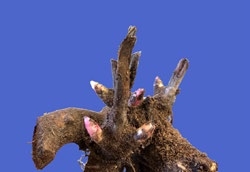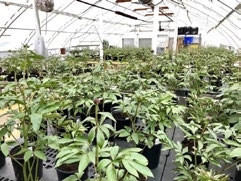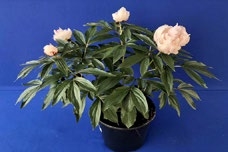Container Production of Herbaceous Peonies: Information for Greenhouse and Nursery Operators
ID
SPES-388P
EXPERT REVIEWED
Introduction
Herbaceous peonies (Paeonia lactiflora Pall.) are popular low-maintenance landscape perennials in temperate regions. They produce large, showy flowers with many forms and colors from early May to July (Fig. 1). There are more than 4,000 herbaceous peony cultivars registered by the American Peony Society, and hundreds of cultivars are still widely grown today across North America (APS 2022). Peonies need cold winter climates to grow well. They can be grown successfully in U.S. Department of Agriculture hardiness zones 3 to 8 and can survive down to zone 9, but are unlikely to flower. As a rule of thumb, if you can grow apples, flowering crabapples (both Malus), and lilacs (Syringa), you can also grow herbaceous peonies (Michener and Adelman 2017). More than 1million potted herbaceous peonies, valued at $12.6 million, were sold in 2020 (USDA 2021).

Herbaceous peony is a popular cut flower worldwide, traditionally grown for Mother’s Day and wedding markets. The Netherlands is the world’s largest supplier of cut peonies, with approximately 55 million stems sold annually (Kamenetsky and Dole 2012). The most popular cultivar for cut peonies is ‘Sarah Bernhardt’, which accounts for more than half of cut peony production. Other popular cut peony cultivars in the United States are ‘Karl Rosenfeld’, ‘Dr. Alexander Fleming’, ‘Duchesse De Nemours’, ‘Kansas’, ‘Festiva Maxima’, and ‘Red Charm’.
The main market for peonies in Virginia is containerized production for home landscapes. The popular landscape cultivars in Virginia are ‘Sarah Bernhardt’, ‘Karl Rosenfeld’, ‘Festiva Maxima’, ‘Dr. Alexander Fleming’, ‘Inspecteur Lavergne’, ‘Felix Crousse’, ‘Mother’s Choice’, ‘Raspberry Sundae’, ‘Coral Sunset’, ‘Do Tell’, and ‘Bowl of Beauty’. The best time to market peonies in Virginia is from March through May when the plants are in bud or in flower.
Propagules
Peonies are propagated from crowns, which are perennial underground stems that serve as energy storage centers with a number of renewal buds growing on the surface (Fig. 2).

Peony crowns with buds are also described as “crowns with eyes.” They are commonly sold as small crowns with 3 to 5 or more eyes. Most of the peony crowns sold in the United States are grown and harvested in the Netherlands. They are also available from some U.S. growers located mainly in Oregon and Michigan. Crowns are dug after the plants enter dormancy in the fall and may be available earlier from nurseries located in the U.S.
A 1-gallon pot is suitable for potting up smaller peony crowns while 2- or 3-gallon pots should be used for larger crowns (6 to 10 eyes). There is very little difference in finish time between plants grown in these container sizes. Crowns should be planted with 2 inches of soilless substrate covering the crowns. The best time for potting peony crowns for the spring market is in the fall prior to the desired market date and as soon as the crowns are available. Peony crowns are held in cold storage for spring planting, but place orders early in the fall for the best selection of cultivars.
Production Inputs and Root Zone Management
The growing substrate must be able to hold moisture and allow enough drainage and porosity for good root development. Research shows that nursery mixes such as 60% hydro fiber and 40% peat, or commercially formulated peat-based substrates amended with composted pine bark at a 1:1 ratio by volume, work well.
Controlled released fertilizers (CRF, such as 17-5-11 Osmocote Pro 12-14 month) may be incorporated into the substrate at the low recommendation rates. A rate of 9 lbs/yd3 incorporated before potting provided a good nutrient balance in research trials.
Irrigate the plants immediately after potting to ensure that crowns are in good contact with the substrate. Irrigate peonies from overhead during the morning, and if possible, avoid late-afternoon or evening irrigations. The amount of water applied depends on temperature and evaporation. The substrate should not dry out during production.
Avoid wet roots, especially in the winter because peonies are dormant and more prone to root rots. Ensure plants are grown in a location that is well-drained such as a container pad, greenhouse, or cold frame. Avoid placing peonies in an area where irrigation or rainfall may pool.
The recommended range for pH is 5.5 to 7.0, and 0.8 to 3.0 ds/m for electrical conductivity (i.e. soluble fertilizer salts) as tested by the pour-through method, which estimates the nutrients available to container-grown plants by measuring how well the leachate (the solution that drains from containers) conduct electricity (LeBude and Bilderback 2009). Monitor the substrate pH and EC monthly. If the substrate pH drifts below the optimal pH range, apply liquid lime according to label directions. Other methods to raise substrate pH include applying hydrated lime or potassium bicarbonate. If the substrate pH drifts above the recommended pH range, then perform an acid water drench. When EC levels begin to rise or accumulate above the optimal EC level, clear water applications can be used to flush salts, thereby reducing EC.
Chilling/Vernalization
As with many perennial species, herbaceous peonies need a cold winter period (vernalization) for spring shoot emergence and flowering.
Peonies are potted in October to November in Virginia, after growers receive the crowns. Chilling can be accomplished under outdoor conditions or controlled conditions.
If chilled under outdoor conditions, containerized peonies can be held outdoors from potting until late-January, 2 to 3 months, to ensure sufficient natural chilling (zones 3-6, longer for zones 7-8. (NOTE: the chilling requirements of only a limited number of cultivars are satisfied by zone 8 winter temperatures.) During the winter, pots should be covered with frost blankets when temperatures are below 20˚F for winter protection and uncovered to ventilate when temperatures are above 40˚F. Rodenticide bait stations should be placed among the plants before covering and filled periodically during the winter.
For controlled chilling, potted plants can be left outdoors for about a month or placed in a 50˚F cooler for about 5 weeks for rooting and then moved to a cooler at 40˚F for a minimum of 3 weeks. If you skip the rooting period, potted plants should be kept in a cooler at 40˚F for a minimum of 6 weeks.
If forcing plants in a heated greenhouse after sufficient chilling, plants can be market-ready in 6 to 8 weeks, with buds showing color (Fig. 3). Maximum day/minimum night temperatures of the greenhouse should be maintained at 50-73˚F (Hall et al. 2007). High night temperatures late in the season cause blasting/abortion of the peony flower buds, resulting in less marketable plants (Fig. 4). Forcing peonies in a greenhouse can produce much earlier and higher-quality plants with a greater number of shoots and flowering shoots for the market.


If growing plants in an unheated cold frame after sufficient chilling, plants will generally flower earlier and suffer less damage than plants in the nursery. Keep the cold frame well ventilated late in the season to avoid high temperatures.
Challenges with Containerized Production
Production challenges for containerized peonies include control of plant size and promotion of flowering. Container-grown peonies typically have fewer shoots and flowers compared to field-grown peonies. While they are not required for peony production, applying proper plant growth regulators can help address these production challenges to produce more marketable plants (Fig. 5).

Plant Growth Regulators
Gibberellic acid (GA3) can reduce the production time by enhancing earlier and more uniform shoot emergence and earlier flowering. GA3 may also increase the numbers of shoots and flowering shoots, and the percentage of plants flowering, resulting in higher quality plants. GA3 can be applied to herbaceous peonies to partially replace the chilling (vernalization) requirement, especially in southern areas (USDA hardiness zones 7-8) in mild winters, when peonies might not receive adequate chilling.
A 100 ppm GA3 drench at 8.5 oz/pot for 1-gallon plants is recommended for herbaceous peony. It can be applied any time after rooting in the fall until shoot emergence begins in the spring. Earlier applications result in shorter production time and a greater number of shoots and flowers in some cultivars. For peonies grown under controlled chilling and greenhouse forcing, GA3 applied just before chilling reduced production time of ‘Sarah Bernhardt’ and ‘Inspecteur Lavergne’ plants by 15 days. Florgib (Fine Americas Inc.) is a commercial GA3 that can be used for peonies. A 1-gallon jug of Florgib can treat 6,000 peony plants at this rate, costing less than 2 cents per plant.
Under greenhouse forcing conditions, plant growth retardants (such as uniconazole) can be used early at shoot emergence to maintain compact plants and enhance foliage color, which will improve marketability. Drenches of 15 ppm uniconazole with 12 oz/pot are recommended for 1-gallon potted peonies, and can be applied one week after moving plants into the greenhouse. Growth retardants have been less effective under nursery or cold frame conditions.
Pests and Pathogens
Peony pests and pathogens can be controlled by a combination of cultural management practices and chemicals.
Botrytis blight and tobacco rattle virus are the most common diseases of containerized peonies. Botrytis blight can cause shoots and flower buds to blacken and die, reducing the number of flowers and resulting in unattractive and unmarketable plants (Fig. 6). Tobacco rattle virus is a nematode-vectored virus that can cause discoloration or distortion of plant foliage, resulting in damaged and unmarketable plants (Fig. 7, Owen et al. 2017). Especially for plants grown under nursery conditions, spring cold damage after shoot emergence can increase susceptibility to Botrytis blight and TRV. Thrips can also be found in greenhouse-grown plants.


Prevention is the best practice for pests and pathogens. Make sure the production site is clean. Always use clean, disease-free plant material, substrate, and pots. Peony crowns should be treated with a broad spectrum fungicide before potting and again 2 weeks after potting to protect plants from fungal infection. Keep proper spacing and ventilation between plants for good airflow during the growing season and avoid temperature extremes. For nursery-grown peonies, moving plants to a cold frame after emergence in spring may avoid spring cold damage.
Monitor plants for pathogens and pests during production. Remove infected plant parts or plants and apply a fungicide spray or drench when Botrytis blight is observed on shoots, foliage, or flower buds in the spring. Also, an appropriate insecticide should be applied as soon as thrips are observed. Consult Virginia Cooperative Extension Pest Management Guide: Horticulture and Forest Crops (Hong and Day, 2022) for appropriate fungicide and insecticide recommendations for commercial production.
Carryover Plant Care – Plants Held Over For Future Sales
Some growers plan on a two-winter production cycle to produce larger plants with a greater number of flowers. Others sell as many of their first-year plants as possible and carry over the remaining plants. Carryover peony plants should be kept in a cool, sunny place for continued growth and good development of renewal buds. Do not remove the leaves before natural leaf senescence (death) in October. Early removal may interrupt bud development on the underground crowns, resulting in poor growth and flowering in the next growing season. Follow the overwintering procedures outlined above.
Sample Production Schedule (Estimate based on Central Virginia; adjust as necessary)
Potting: October-November
Rooting: One month outdoors
Outdoor winter chilling (vernalization): November-January
Cooler-based chilling (vernalization): Minimum 3 weeks at 32-41˚F
Greenhouse forcing: February- April
Spring nursery growing to flowering: March-May
Carryover plants: June-October
References
American Peony Society. 2022. http://americanpeonysociety.org.
Hall, A.J., J.L. Catley, and E.F. Walton. 2007. “The effect of forcing temperature on peony shoot and flower development.” Scientia Horticulturae113:188-195.
Hong C., and E. Day, eds. 2022. Pest Management Guide: Horticulture and Forest Crops. Virginia Cooperative Extension 456-017. https://www.pubs.ext.vt.edu/456/456-017/456-017.html.
Kamenetsky, R., and J. Dole. 2012. “Herbaceous peony (Paeonia): Genetics, physiology and cut flower production.” Floriculture and Ornamental Biotechnology. 6:62-77.
LeBude A.V., and T.E. Bilderback. 2009. The pour-through extraction procedure: A nutrient management tool for nursery crops. NC State Univ. Coop. Ext. 1-8. https://content.ces.ncsu.edu/the-pour-through-extraction-procedure-a-nutrient-management-tool-for-nursery-crops
Michener D.C., and C.A. Adelman. 2017. “Peony: The best varieties for your garden.” Timber Press Inc. 55-65.
Owen, W.G., J. Byrne, and F. Warner. 2017. “Peony: Tobacco Rattle Virus.” e-Gro Alert. 6(36):1-5.
U.S. Department of Agriculture. 2021. “Herbaceous perennial plants sold in pots, peony – states and total: 2019 and 2020.” Floriculture Crops 2020 Summary. USDA, National Agricultural Statistics Service. 52-53.
Virginia Cooperative Extension materials are available for public use, reprint, or citation without further permission, provided the use includes credit to the author and to Virginia Cooperative Extension, Virginia Tech, and Virginia State University.
Virginia Cooperative Extension is a partnership of Virginia Tech, Virginia State University, the U.S. Department of Agriculture (USDA), and local governments, and is an equal opportunity employer. For the full non-discrimination statement, please visit ext.vt.edu/accessibility.
Publication Date
October 26, 2022



